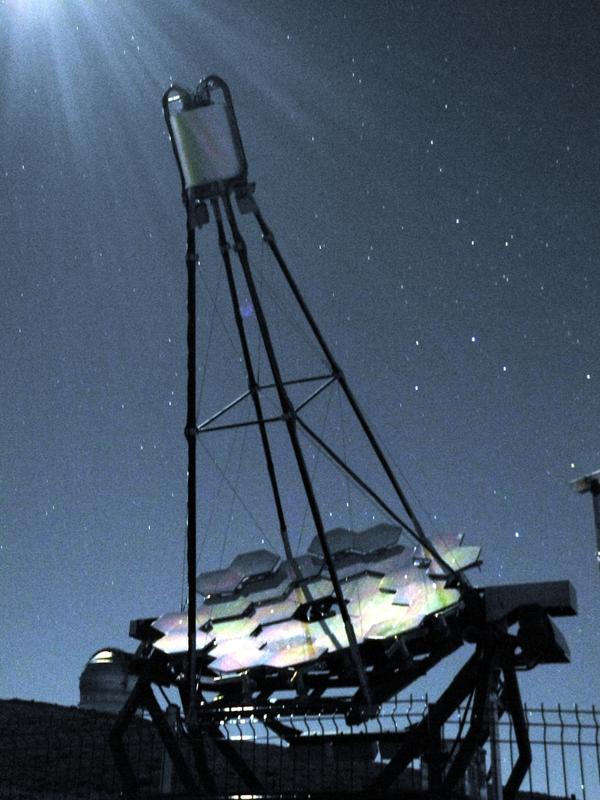
Würzburg Astrophysics Celebrates Breakthrough in Astroparticle Physics

This telescope (First G-APD Cherenkov telescope) in the European Northern Observatory on La Palma uses the new camera technology – even during a full moon.
(Photo: Daniela Dorner)
The Würzburg astrophysics department is thrilled: On 27 November, the Deutsche Physikalische Gesellschaft (DPG) announced that the 7,500 euro Gustav Hertz Award would be shared by scientist Daniela Dorner (35) and her colleague Thomas Bretz (40), who spent several years researching at the University of Würzburg. The awards will be presented in Berlin on March 2015.
The DPG commends the laureates' “original and seminal impetus” to astroparticle physics with their contributions to enhancing Cherenkov telescopes. Bretz and Dorner achieved the success during their work for FACT (First Geiger-Mode Avalanche Photodiode Cherenkov Telescope), a joint project of Germany and Switzerland, which also involves scientists from TU Dortmund, ETH Zurich and the University of Geneva.
The challenge
So far, Cherenkov telescopes for observing cosmic gamma radiation have been based on detecting single photons by means of so-called photomultiplier tubes. Requiring high voltage in the kilovolt range, these photosensors are difficult to operate with outdoor telescopes. Moreover, they overload in the presence of bright moonlight and have to be switched off, which regularly results in data gaps.
But non-stop observation is crucial particularly in case of variable astronomical sources. Especially active galactic nuclei exhibit extreme variations in brightness which are crucial in order to understand physical processes taking place in the vicinity of black holes. Making progress in this field called for highly sensitive photosensors that require little electricity and no high-voltage supply while featuring nanosecond time resolution.
Putting an unusual idea into practice
To overcome this challenge, the scientists used an idea of the late physicist Eckhart Lorenz of the Max Planck Institute for Physics in Munich, namely to develop a camera with silicon-based semiconducting photosensors for a Cherenkov telescope. This idea seemed unsuitable at first and many experts advised against it.
But Thomas Bretz and Daniela Dorner nevertheless dared take the FACT collaboration one step further: They designed a camera, which was built at ETH Zurich, and installed it in a telescope on the Canary Island of La Palma in the Roque de los Muchachos Observatory, 2,200 metres above sea level.
The laureates' feat
The FACT camera is tolerant to bright moonlight. Bretz succeeded in optimising the camera until it clearly outperformed previous technology in terms of data quality. The camera produced a much greater data flow which Dorner “tamed” by using databases. The two researchers moreover designed a sophisticated feedback system which assures steady data consistency.
They prepared the software so as to enable the observatory to operate smoothly with the new telescope technology. After a brief instruction, even an ordinary person is capable of observing astronomical gamma sources with the telescope such as the Crab Nebula, a 1000-year-old supernova remnant in the constellation of Taurus, or the Markarian 421 blazar located in the constellation Ursa Major.
Although intended as a joke initially, the two laureates implemented another nifty feature: The observations made by the new system can be controlled from a smartphone interface. Bretz and Dorner have successfully encapsulated and automated the complex functionality of the FACT technology like in a Swiss pocket knife.
Where the new technology is used
The new technology will also be used in the MAGIC telescope system of the European Northern Observatory on La Palma. The team of Karl Mannheim, head of the astronomy department in Würzburg, is instrumental in operating MAGIC. “The new camera has become an established technology,” the professor says. He believes that it will also be used in future large-scale machines such as the Cherenkov Telescope Array (CTA) which is set to take up operation in 2020.
And maybe, one day, FACT will also help realise the idea that had bothered the two laureates years ago already: to create a network of Cherenkov telescopes distributed all over the planet to close the data gaps resulting from Earth's rotation. When the sun is about to rise in La Palma, first the telescopes in America would take over followed by those in Asia until the sun goes down again on La Palma.
Vita of the laureates
Thomas Bretz, born in Frankfurt am Main in 1974, studied physics at TU Munich. In 2000, he joined Karl Mannheim's team at the university observatory in Göttingen. Two years later, the team relocated to the University of Würzburg where he met Daniela Dorner, who studied physics at the time. Inspired by Bretz, she joined projects dealing with the MAGIC telescope system. As a postdoc, he joined the École Polytechnique in Lausanne followed by ETH Zurich in 2012. In 2014, he became a junior professor at RWTH Aachen.
Born in 1979 Daniela Dorner from Amberg studied physics in Bayreuth and Würzburg. She completed her doctoral thesis in Würzburg in 2008. As a postdoc, she joined the ISDC Data Centre for Astrophysics in Geneva where she participated in a joint project of ETH Zurich and the University of Geneva. She returned to Würzburg in 2012 where she has been doing research in a joint project funded by the Federal Ministry of Education and Research (BMBF). Daniela Dorner likes to spend her free time with creative writing, doing collages and playing badminton.
Weitere Informationen:
http://www.astro.uni-wuerzburg.de/en Visit homepage of the Astronomy Department












